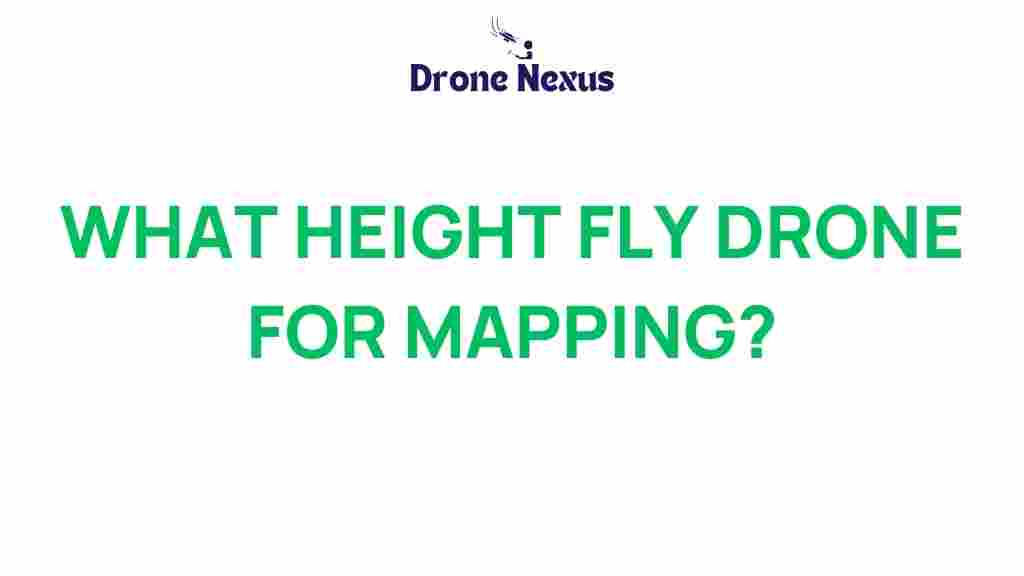Discover the Ideal Height for Drones in Mapping Projects
In recent years, the use of drones in mapping projects has revolutionized the way we gather spatial data. Drone mapping allows for high-resolution aerial imagery and precise measurements, making it an invaluable tool for industries such as agriculture, construction, and environmental monitoring. One of the key factors that influence the quality of drone mapping is the height at which the drone operates. In this article, we will explore the ideal height for drones in mapping projects, ensuring optimal results while adhering to regulatory guidelines.
Understanding Drone Mapping
Drone mapping involves capturing images of the earth’s surface using unmanned aerial vehicles (UAVs). These images are then processed using specialized software to create detailed maps and 3D models. The height at which the drone flies can significantly affect the data quality, coverage, and detail obtained from the mapping process.
The Importance of Height in Drone Mapping
The height of the drone during mapping projects impacts several key factors:
- Image Resolution: The higher the drone flies, the lower the image resolution, which can lead to loss of detail.
- Coverage Area: Flying at a higher altitude allows the drone to cover larger areas in less time, but may sacrifice detail.
- Regulatory Compliance: Different regions have regulations about how high drones can fly, affecting mission planning.
Determining the Ideal Height for Drone Mapping
Finding the perfect altitude for drone mapping is not a one-size-fits-all solution. Various factors need to be considered:
1. Project Requirements
First and foremost, define what you need from your mapping project:
- Type of Data: Are you capturing detailed topographical data or general landscape imagery?
- Spatial Resolution: What level of detail is required for your specific application?
2. Drone Specifications
Different drones have varying capabilities, affecting their optimal flight heights:
- Camera Quality: High-resolution cameras can capture more detail, allowing for higher flight altitudes.
- Sensor Type: LiDAR sensors may require different heights compared to RGB cameras.
3. Environmental Considerations
Weather and terrain can also dictate the best height for your drone mapping project:
- Wind Conditions: Strong winds can affect stability; flying lower may help maintain control.
- Obstructions: Trees, buildings, and other obstacles can limit flight altitude.
4. Regulatory Guidelines
Before launching your drone, it’s crucial to understand local regulations regarding drone flight heights. In many countries, the general maximum altitude for commercial drone operations is:
- 400 feet above ground level (AGL) in the United States.
- 120 meters in Canada.
- Various limits in European countries based on airspace classification.
Check with your local aviation authority to ensure compliance with regulations.
Step-by-Step Process for Determining Flight Height
Follow this step-by-step guide to determine the ideal height for your drone mapping project:
Step 1: Define Your Objectives
Clearly outline the goals of your mapping project. Consider the level of detail required and the size of the area to be mapped.
Step 2: Research Drone Specifications
Understand the capabilities of your drone, including camera resolution and maximum flight altitude. Refer to your drone’s manual for this information.
Step 3: Assess Environmental Factors
Evaluate the weather conditions and the landscape. Identify potential obstacles and consider the impact of wind on your flight.
Step 4: Review Regulatory Guidelines
Consult your local regulations to ensure that your planned altitude complies with the law.
Step 5: Plan Your Flight Path
Using mapping software, plan out your flight path, taking into account the height determined in the previous steps. Ensure that your path maximizes coverage while maintaining the desired resolution.
Step 6: Conduct Test Flights
Before the main mapping project, conduct test flights at different altitudes to evaluate the image quality and coverage. This will help you fine-tune your approach.
Troubleshooting Common Issues
Even with careful planning, issues may arise during drone mapping projects. Here are some common challenges and how to address them:
1. Poor Image Quality
If images are blurry or lack detail:
- Check your camera settings and ensure they are optimized for the altitude.
- Consider flying at a lower altitude to capture finer details.
2. Incomplete Coverage
If your mapping area is not fully covered:
- Adjust your flight path to ensure overlap between images.
- Increase the altitude to cover more ground, but keep an eye on resolution.
3. Regulatory Issues
If you encounter legal restrictions:
- Consult with local authorities for clarification on flight regulations.
- Consider flying in designated drone-friendly areas if restrictions apply.
Conclusion
Determining the ideal height for drones in mapping projects is crucial for capturing high-quality data. By understanding the specific requirements of your project, assessing your drone’s capabilities, and complying with regulations, you can optimize your mapping efforts. Remember to conduct test flights and make adjustments as necessary to ensure the best results. With the right approach, drone mapping can provide unparalleled insight into the landscapes you wish to analyze.
For more in-depth information on drone mapping techniques, visit this resource. If you’re interested in learning more about drone technology, check out this article for further insights.
This article is in the category Applications and created by DroneNexus Team
